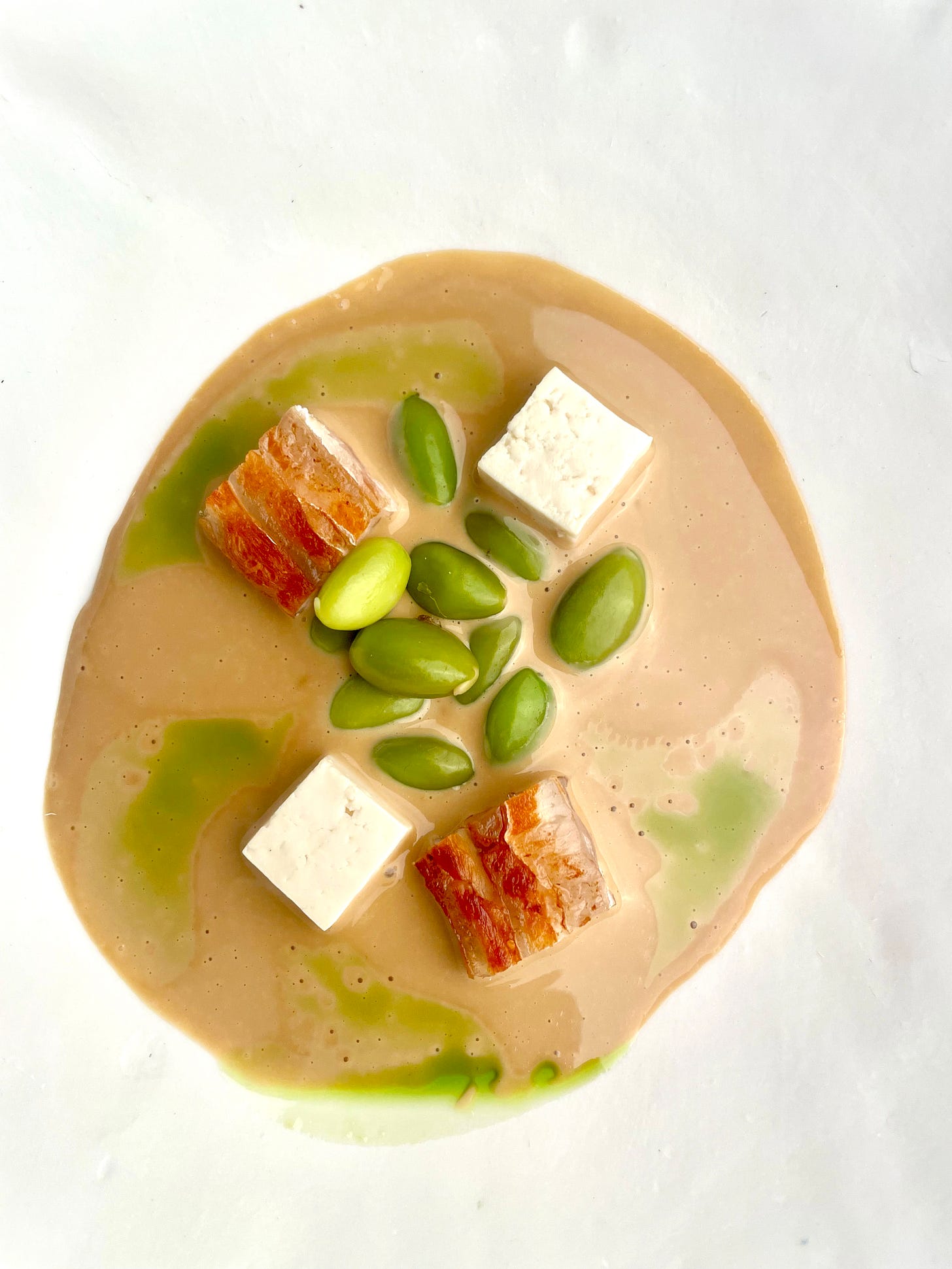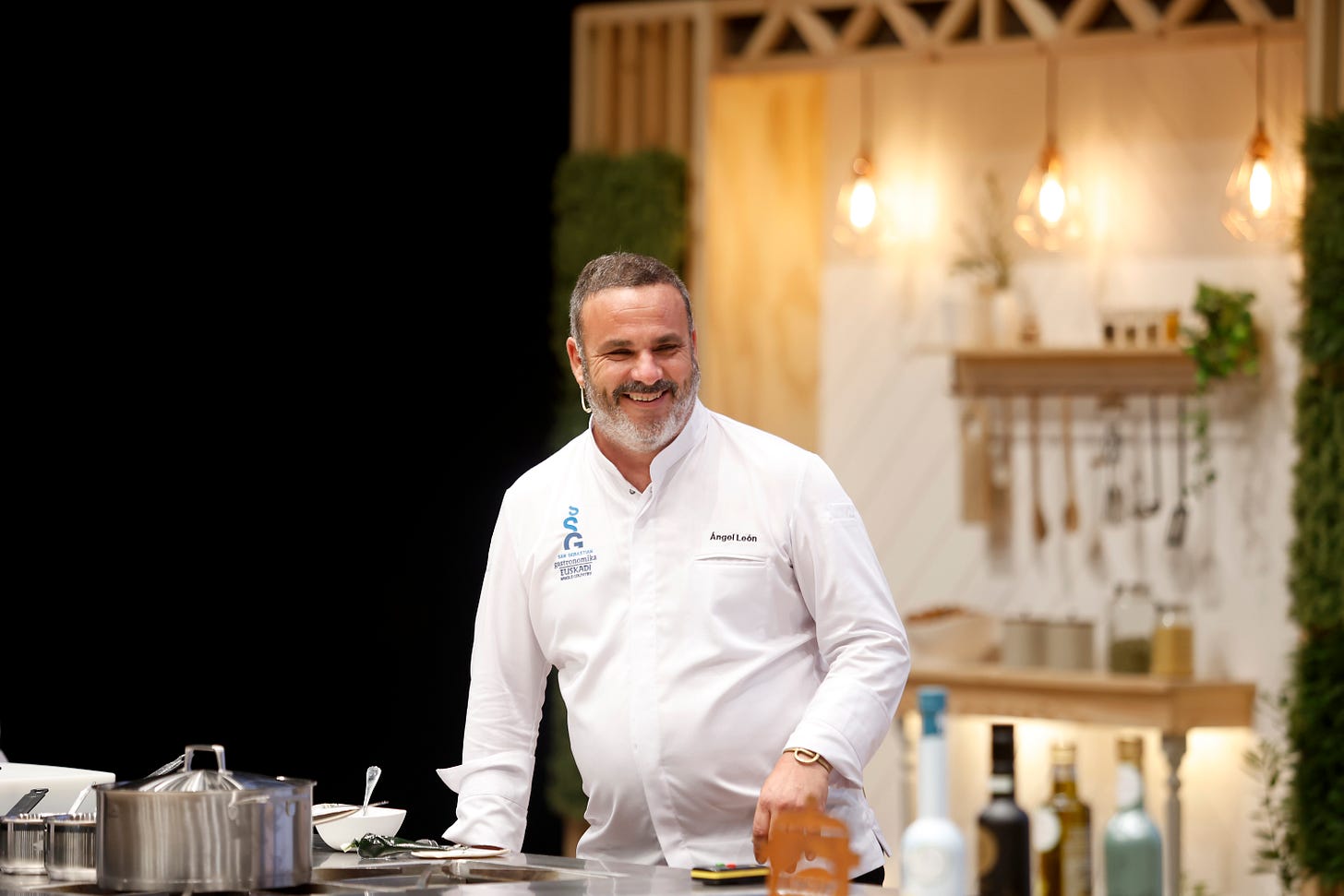“The Plankton Chef” Unveils A New Protein From The Sea
Ángel León introduces his latest find at San Sebastian Gastronomika
These days, it’s hard not to feel like only terrible things are happening in the world, and this past week has been a particularly difficult one for all of us who just want to be able to lead a peaceful and dignified life.
As someone who has written more than her fair share of depressing stories - my former colleagues even came up with a nickname which I won’t print here - I know why many journalists cover them.
The cynics among us may say it’s about jumping on the breaking news bandwagon and getting clicks and eyeballs, but for most people I’ve worked with, it’s the need to bear witness in the hope that we can get readers to care for the plight of others, even if they are on the opposite ends of the world.
That’s also why I know we need moments of calm and why I’m going for something altogether lighter and more hopeful for this week’s Thin Ink, both for the topic and my own pickings. I hope you enjoy it.
What do you see when you look at the beautiful creation in the picture above? Will you be surprised if I tell you that two of the key proteins in that dish came from a single source - a leguminous plant that grows just a few metres from shorelines all over the world?
Meet Canavalia rosea, a halophyte or salt-tolerant plant, that has 50% protein and 40% carbohydrates. It also has an impressive array of vitamins and minerals, including iron.
Those lush edamame-lookalike green beans nestled in the middle of the dish? They came from this “marine soybean”.
The perfectly square tofu cubes? Made by boiling the seawater in which the soybean grows. This concentrated the magnesium chloride responsible for the rennet in soya milk protein. You then strain and press the rennet and voilà - tofu!
The other cubes that resemble bacon? Made with moray eels.
This was the crowning glory of four delightful dishes unveiled on Tuesday night by Ángel León, a multi-Michelin-starred chef affectionately known amongst his peers and Spaniards as Chef del Mar (The Chef of the Sea) and “The Plankton Chef” for his commitment to the treasures of the sea.
But it’s not the lobsters, the caviar, or the uni - the typical seafood products that appear in fine-dining establishments - that get Ángel excited. His interest lies in the lesser-known and even-lesser-tried things like the bellies of discarded fish, a sea worm normally used as fish bait in Spain, and these unassuming looking pods.
So a few nights ago, he was at San Sebastian Gastronomika, speaking to a crowd made up of the pioneers of modern Spanish cooking - think Ferran Adrià and Andoni Luis Aduriz - and food enthusiasts.
It was the last session in a long day, finishing around 8 in the evening, but his energy, curiosity, and excitement were infectious and the audience was clearly wowed by all the dishes Ángel’s team has prepared after painstaking research.
There was the aforementioned marine stew with tofu, grilled marine pod blanketed by a striking pil-pil sauce made of plankton, beans with marine bacon - the latter made with moray eels, and marine yuba and curd with marine soy molasses.
In all these dishes, the star was Canavalia rosea or “marine soybean” as Ángel calls it.
Ángel was born and raised in Cádiz, one of Western Europe’s oldest cities and the capital of the southernmost province on the Iberian peninsula. It’s a place surrounded by water, which was just as well, because the sea “saved” him, he said in an interview with TIME magazine.
He was a terrible student and barely graduated high school, but being out on the water in his dad’s small fishing boat was his happy place. So perhaps it wasn’t surprising that he has spent his entire career devoted to what the waters have to offer.
According to the FAO, the UN food agency where he has been named a “Food Hero”, he got the culinary-minded’s attention in 2008 when he served the world’s first phytoplankton menu. Nearly a decade later, he came up with a bio-luminescent cocktail made with sea algae that naturally lights up in fluorescent blue.
Below are a few other things Ángel has cooked at his three-Michelin-star restaurant Aponiente in Cádiz, courtesy of the TIME article.
“He discovered that fish eyes, cooked at 55°C in a thermal circulator until the gelatin collapsed, made excellent thickening agents for umami-rich sauces. Next he found that micro-algae could sequester the impurities of cloudy kitchen stocks the same way an egg white does in classical French cooking.”
“In the years since, León has used sea bass to make mortadella; mussels to make blood sausage; moray eel skin to mimic crispy pigskins; boiled hake to fashion fettuccine noodles; and various parts of a tuna’s head to create a towering, gelatinous, fall-apart osso buco.”
He has also introduced sea bacon, made from the discarded bellies of under-utilised fish such as white seabream and smoked over pineapple.
Ángel is on a mission to find flavours that are delicious as well as sustainable in the waters, and he is determined to bring us along with it.
“In the world, it seems like we’ve discovered everything but there’s still a lot of things to discover in the sea,” he told me after his presentation of the marine soybean.
“When we see the sea, we just see the fish. But that’s not all. I’m just a chef… but I want to offer new proteins and open people’s minds.”
It hasn’t always been easy though. In the early days, when he used discarded fish in his dishes, customers would criticise him because to them, this wasn’t food. It is now “much easier than before” since people are more sensitive to issues around nature and waste, he said.
So let’s go back to the marine soybean, which Ángel is convinced will become a popular source of proteins and vitamins in the next 10-15 years, and which Juan Martín, Aponiente’s resident marine biologist, discovered during a trip to Venezuela in 2021.
“We’re destroying so much of the Amazon to plant soy to feed domestic animals and we’re using water to grow it. But nature gives us this,” Juan said during the presentation, emphasising that almost all the water we have on earth - nearly 97% - is salt water.
Which is why making something out of a plant like the marine soybean, which grows copiously in saltwater and can be found worldwide, from Australia, India, and Thailand to the Kenya, Belize, and Paraguay, makes a lot of sense.
It will also reduce the need to rely so much on animal products for proteins, because “our need for protein is doing a lot of harm both on the land and in the sea,” said Ángel.
For the past year, the team at Aponiente has been working with the Venezuelan Institute of Scientific Research (IVIC) and the company Marine Vegetables to experiment with the pods, the beans, as well as the leaves.
The results? They’ve been able to make sea soy sauce, black miso, molasses, fermented tofu, and yuba, all from one plant. Aponiente will start serving them in dishes from next year onwards, Ángel promised.
I asked him how he will avoid repeating the experience of serving the sea worms, which he said tasted “very good” and had a lot of umami.
“But when you speak to my mother, she says, “You’re crazy”.”
That time, the diners agreed with his mother and the worms lasted a single day on his menu. Is he confident about the marine soybean?
“I’ll have to make them very delicious or people will complain,” he said, laughing. Still, he’s an optimist.
“But it’ll be easier because people are already used to soy.”

Thin’s Pickings
‘Hard to breathe’: Myanmar communities forced to live among world’s trash - Frontier Myanmar
This piece by Allegra Mendelson and Rachel Moon is part of a six-month investigation, led by Lighthouse Reports with media organisations in five countries including Frontier, that uncovered how Myanmar has been used as a dumping ground for plastic waste from wealthy countries.
Of course, communities are no longer able to advocate for themselves about these issues since the military, which seized power in 2021, is intent on things like bombing refugees (which they did this week) rather than helping the people.
I thought of keeping all the Pickings light but decided to include this, not only because I was marginally involved in this investigation, but also because these days, news from Myanmar are few and far between.
Seeding the Ocean: Inside a Michelin-Starred Chef's Revolutionary Quest to Harvest Rice From the Sea - TIME
This article, by Matt Goulding with beautiful photos by Paolo Verzone, is nearly three years old but given the topic this week, is well worth a read and gives you an insight into Ángel’s thinking than my short piece cannot.
‘I eat to understand’: cook and writer Fuchsia Dunlop on her lifelong love of Chinese cuisine - The Guardian
Tim Lewis spoke to one of my favourite cookbook authors - I reckon her book on Sichuan food is a must-have - about her latest offering while enjoying what sounds like a heavenly dim sum lunch.
As always, please feel free to share this post and send tips and thoughts on mastodon @ThinInk@journa.host, my LinkedIn page, twitter @thinink, or via e-mail thin@thin-ink.net.









I view this piece about Ángel León and his amazing food with a large dose of skepticism primarily because he relies on using products from the sea and creating food that most people will not have access to or are skilled enough to make.
I do agree the oceans represent an unexplored frontier that has potential. But…I wonder about the overall health of the oceans – does it make a lot of sense to harvest from the ocean when we haven’t come close to protecting the health of our seas? How do microplastics and pollution from fertilizers affect these ideas? And even if sea soybeans become a “thing,” how will harvesting occur, replenishing what is taken from the sea, or the impact on other inhabitants that thrive because of the soybeans?
I know you wanted to keep things light this week – I appreciate that – but I wonder, are these pursuits to harvest from the sea worthwhile?
Thanks for this interesting and thought-provoking piece…and I wouldn’t mind tasting one of those tofu squares.